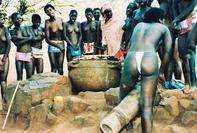Settling in Dzata
Fanciful theories have been used to explain the origins of the Venda, but recent evidence has revealed them to be an amalgam of groups. By the fourth century, modern Northern Province was occupied by Khoisan and Early Iron Age peoples, who interacted through trade, marriage and war.

In the 7th century, the northern reaches were occupied by Ngona and Khoisan. From 800, the Mapungubwe Kingdom emerged, stretching from the Soutpansberg in the south, across the Limpopo River to the Matopos in the north. The kingdom declined from 1240, and the centre of power and trade moved north to the Great Zimbabwe Kingdom.
A shifting of focus to Zimbabwe's Khami and Rozwi empires followed, but the culture did not come to a standstill south of the Limpopo: Shona-Venda and Venda pottery styles developed in the 14th and 15th centuries. There are no stone-walled ruins comparable in size to Great Zimbabwe in the north-eastern part of Northern Province, but those in the mountains do show the link.
Accompanying the emergence of these centres, from about 1400, waves of Shona-speaking migrants from modern Zimbabwe, known by the Venda as Thavatsindi, settled across the Lowveld. At the end of the 17th century, another wave, the Singo, probably of Rozwi origin, fled Danangombe 'Dhlo Dhlo' near the centre of Zimbabwe, on the break-up of the Rozwi empire. They settled first at Tshiendeulu, and then Dzata.
Succession of Rulers
Dzata in the Nzhelele Valley has extensive stone walling, and for some 60 years had a succession of rulers. Most accounts of its history centre around Thoho-ya-Ndou 'Head of the Elephant', who may have been several rulers who took the name on accession to the throne. Some accounts portray him as the man who united Soutpansberg groups to form the Venda. Others say he extended Venda power and boundaries to incorporate neighbouring groups. In 1760, Dzata burnt to the ground.
The fate of Thoho-ya-Ndou is a mystery: he may have fled, with the Ngoma Lungundu, to settle across the Limpopo, or he may have been murdered. With the disappearance of Thoho-ya-Ndou, the kingdom was divided in two. Secessions in the 19th century resulted in even more groups, whose mahosi 'kings' all claim Singo descent. The Venda also had mahosi of other origins.
Laws about succession to the throne are complex, and Venda history has been characterized by frequent succession disputes, which persist to the present.
Imprints on Venda Culture
Although living among the Venda, the Lemba retain traits, such as avoiding pork, that show their distinct origins. Some argue that the Lemba of Northern Province and Zimbabwe are descendants of Arab traders who ranged between East Africa and the Zimbabwean plateau centuries ago.
The Lemba themselves believe they are Black Jews, descendants of the lost tribe of Israel. Whatever their origins, they played an important role as carriers of goods in precolonial iron and gold trading. In the past, no Lemba woman could marry a Venda man, and marriage of Lemba men with Venda women was rare.
Should a Venda woman marry a Lemba, she had to undergo a ceremony to become a Lemba. This still pertains, at least in theory, today. Trade, warfare and intermarriage with Tsonga, Lobedu, Zulu, Swazi and other people have also left their imprints on Venda culture.
Venda Legend: Drum of the Dead

A drum, Ngoma Lungundu 'the drum of the dead or of Mwari', is a central feature of the oral traditions about the Singo: if beaten by the king in times of threat, it would protect the people against attack and allow them to defeat their enemies. The drum struck such fear into enemies’ souls that they fled in terror, fell to the ground in a swoon, or died.
Tradition has it that the drum enabled the Singo to undertake their journey and occupy and hold land south of the Limpopo. At times, when the drum appeared to play itself, the invisible ancestor-god Mwari, who had given the drum to the Singo kings, himself was playing it. Some accounts state that, after the destruction of Dzata, the drum was hidden in a cave near Netshiendeulu, whose inhabitants were its keepers.